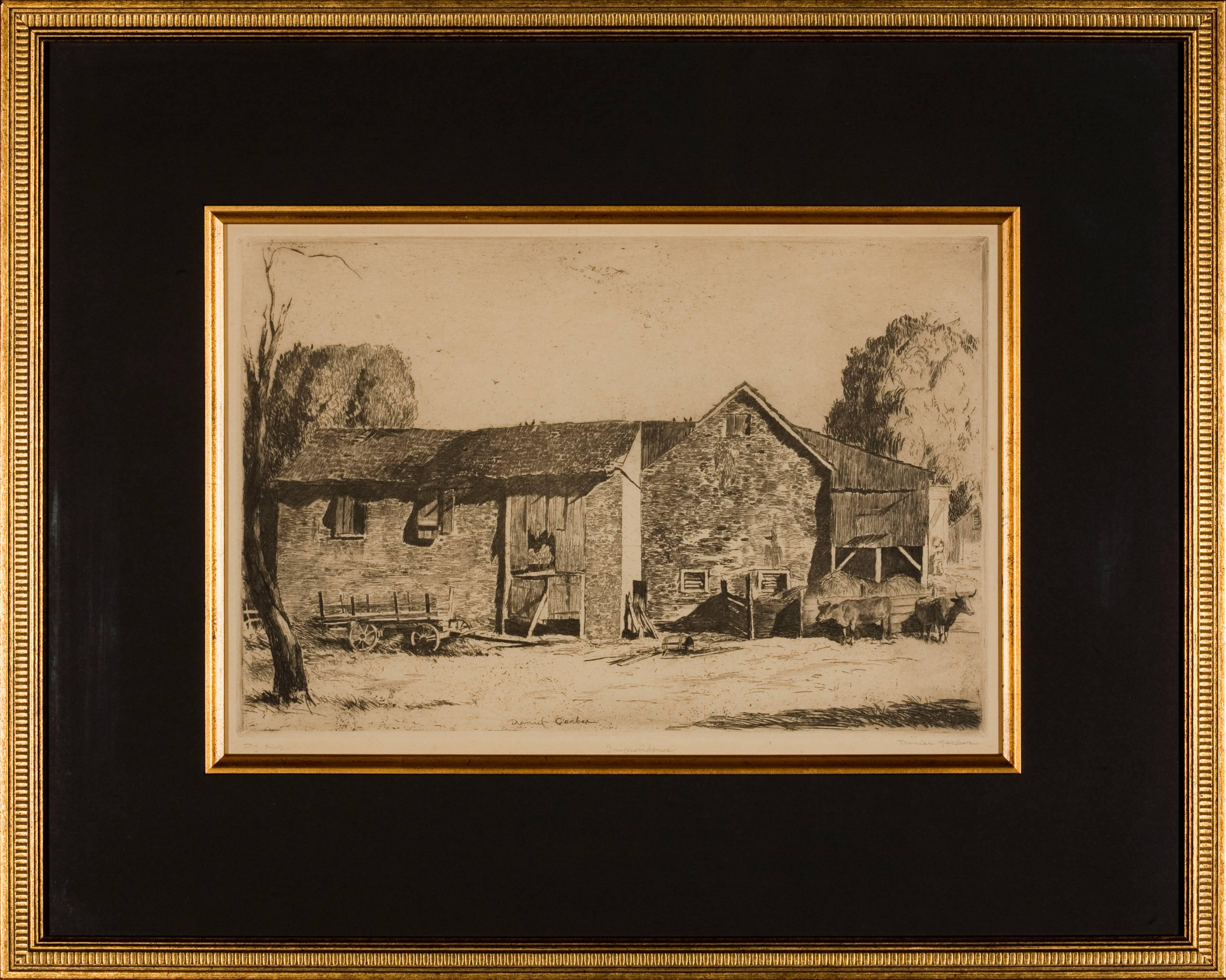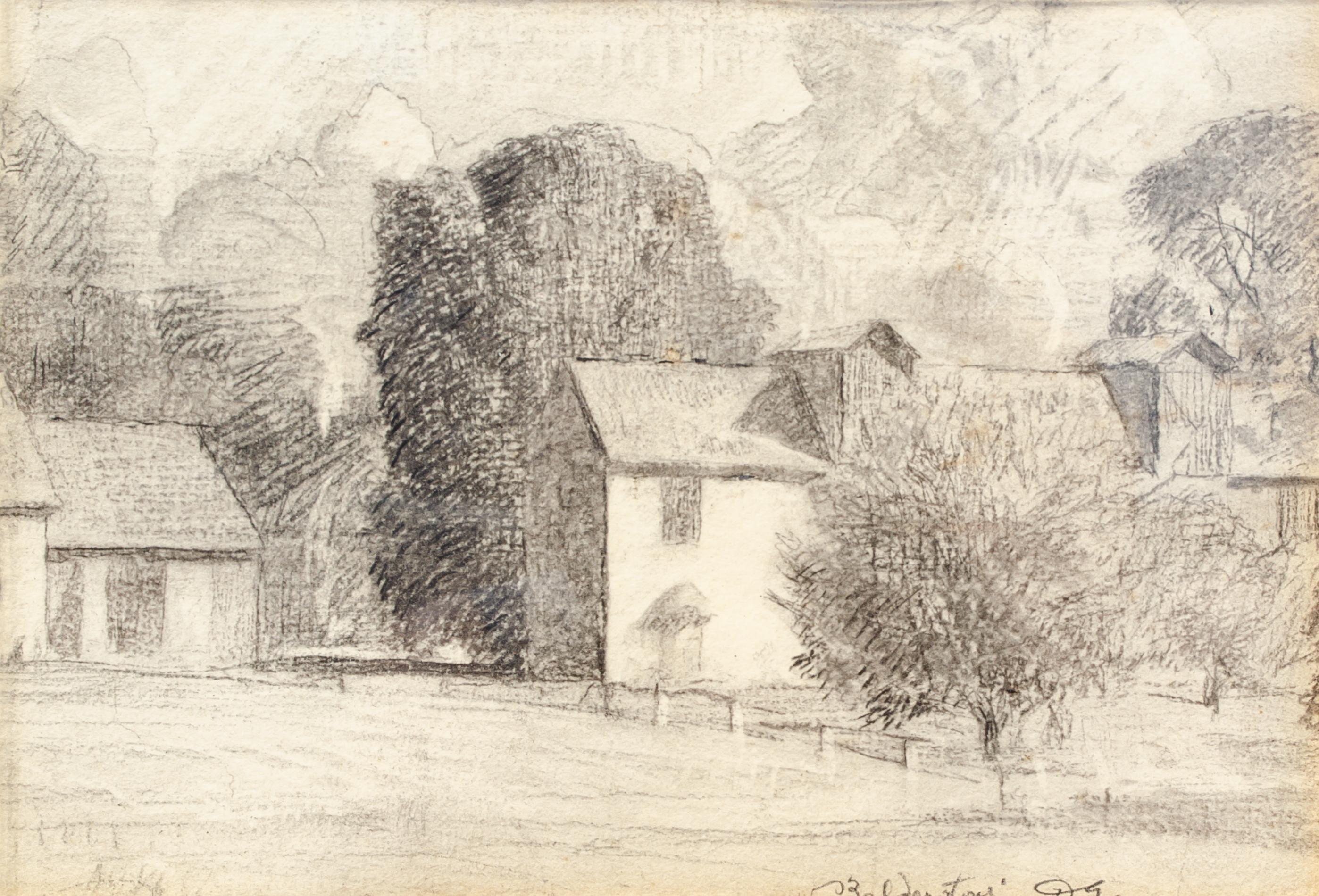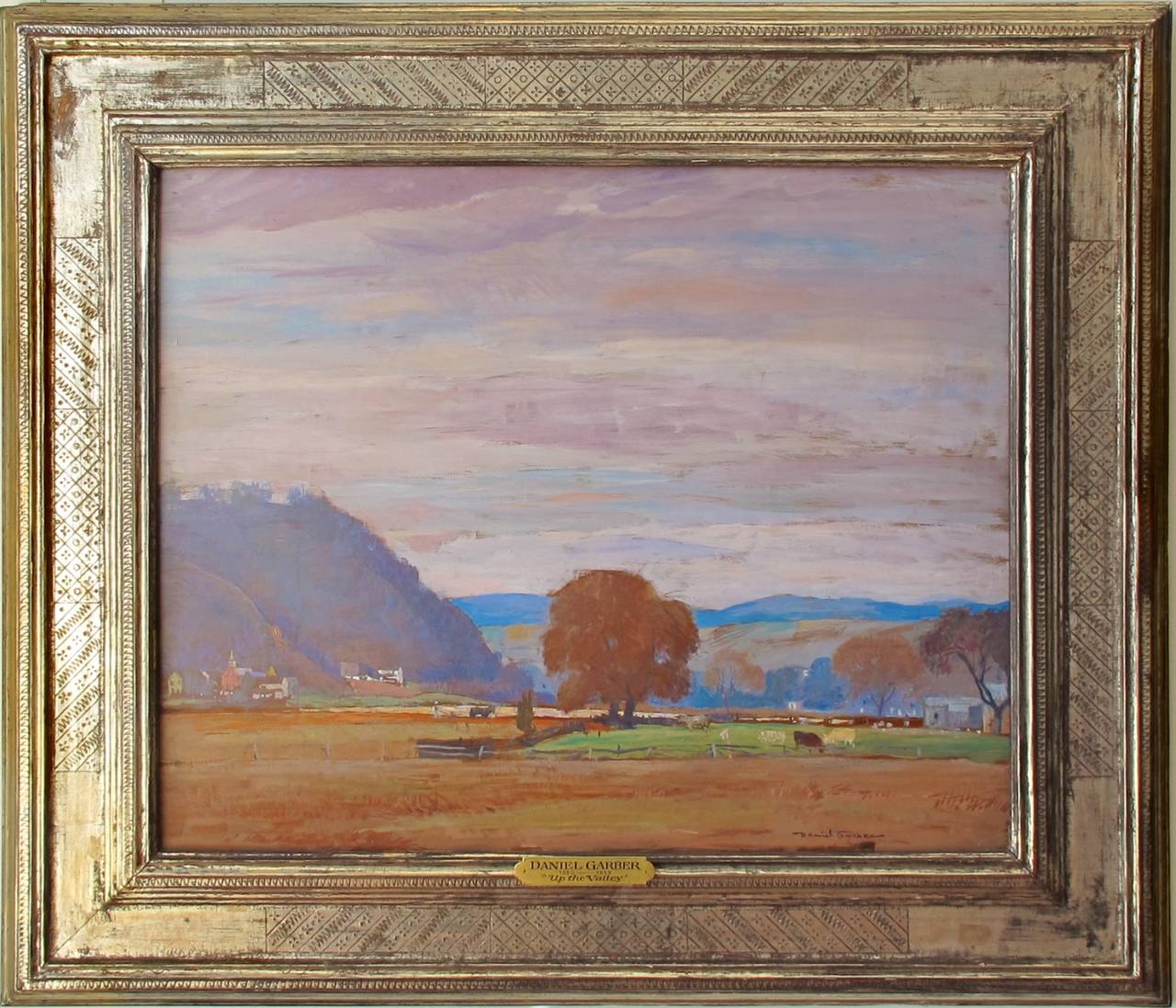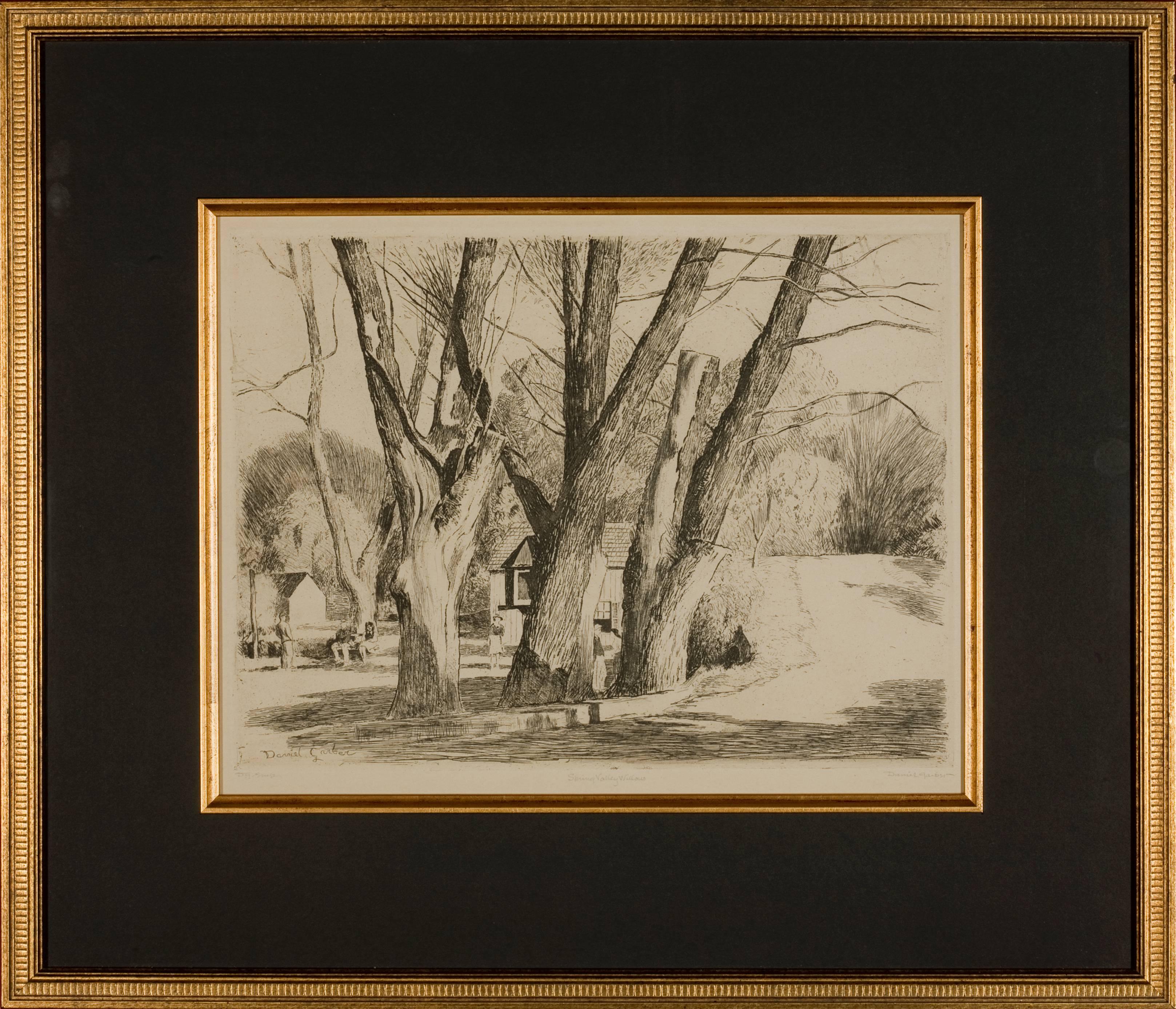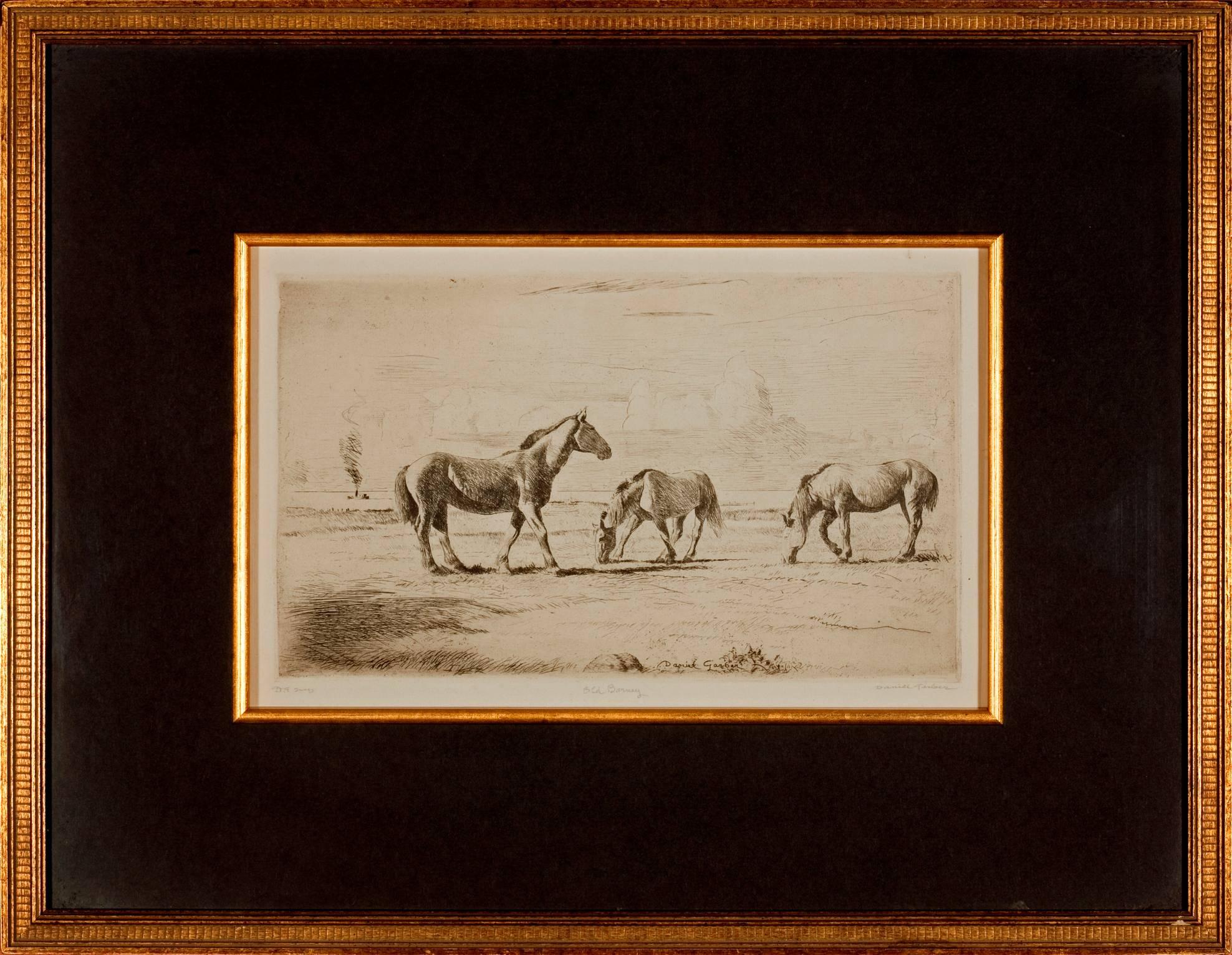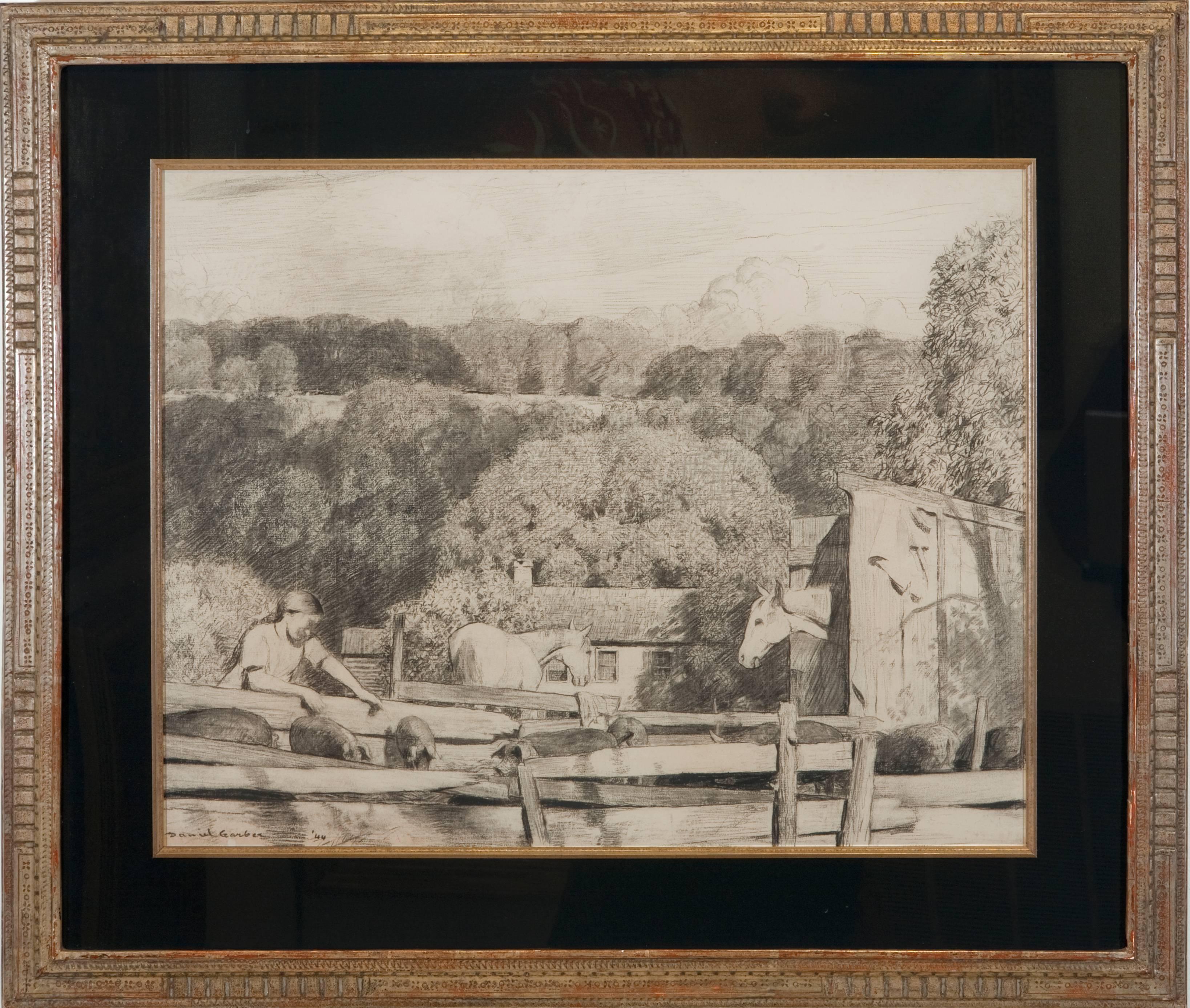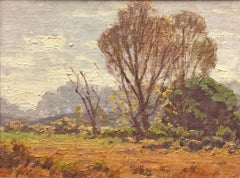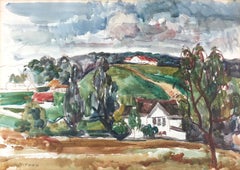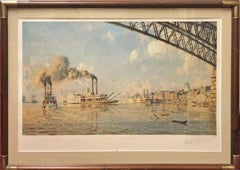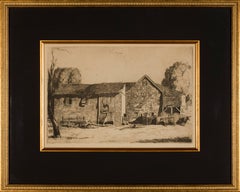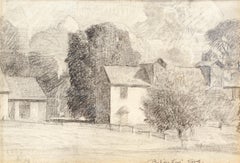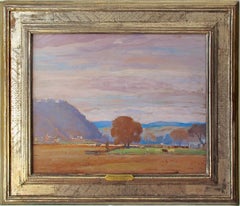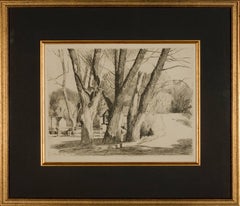Want more images or videos?
Request additional images or videos from the seller
1 of 3
Daniel GarberHarmonville1925
1925
Price Upon Request
Price Upon Request
Price Upon Request
Price Upon Request
Price Upon Request
Price Upon Request
Price Upon Request
Price Upon Request
Price Upon Request
Price Upon Request
Shipping
Retrieving quote...The 1stDibs Promise:
Authenticity Guarantee,
Money-Back Guarantee,
24-Hour Cancellation
About the Item
DANIEL GARBER
"Harmonville, Pennsylvania" c. 1925
Etching printed in black ink on wove paper.
7 7/8 x 11 3/4 inches, full margins.
Signed, titled and inscribed "DG imp" in pencil, lower margin. A very fine impression with all the delicate lines printing clearly and with the tack holes for drying at the extreme sheet edges
Signed and Titled
From a Small Edition of Only 30
Framed Size: 16 x 20 inches approx.
The American artist Daniel Garber was a leading figure in the Pennsylvania School of Landscape Painting, also known as the Pennsylvania Impressionists, a group centered around the village of New Hope in Bucks County, Pennsylvania. Born in North Manchester, Indiana, Garber began his formal art training at the Art Academy of Cincinnati in 1897 where he studied for one year with landscape and figure painter Vincent Nowottny and fraternized with the followers of Frank Duveneck known as the "Duveneck Boys." Through the Duveneck connection, Garber was exposed to less academic influences, and he adopted the Impressionist aesthetics of the Ten American Painters upon that group's showing in Cincinnati in 1898. Garber continued his studies in the summers of 1899 and 1900 at the Darby School in Fort Washington, Pennsylvania. There the emphasis was upon landscape painting, and his teachers Hugh Breckenridge and Thomas Anshutz encouraged their students to experiment. From 1899 until 1905 Garber studied at the Pennsylvania Academy of the Fine Arts in Philadelphia under Anshutz, William Merritt Chase, and Cecilia Beaux. Garber took many of his classes at night to accommodate his work as an illustrator, commercial artist, and portrait painter. Such work included displays for department stores and cover designs for "McClure's," "Scribner's," "Harper's Bazaar," and "The Century" magazines.
Soon Garber's easel paintings began to attract favorable notice. In 1902 two of his portraits were accepted into the Pennsylvania Academy's annual exhibition; two years later his painting, "The Aged Sycamore," was exhibited at the National Academy of Design. His success was strengthened in 1905 when his work was included in the spring exhibition of the Society of American Artists and he received the Cresson Traveling Scholarship from the Pennsylvania Academy, which enabled him to travel in Europe for two years. He visited England, France, and Italy and his signature style began to emerge, characterized by the representation of sunlight with a broad spectrum of pastel and bright colors.
Returning to the United States, Garber and his wife Mary Franklin Garber settled on the Kenderdine Homestead, near Lumberville, Pennsylvania, which was purchased for them by Mary's father. Garber renamed his home Cuttalossa after the creek that was adjacent to the property. Not far from his home, Garber could look across the Delaware River to the great stone quarries at Byram, New Jersey, which he often painted. Garber created a style of landscape painting characterized by romanticized, representational imagery. These scenes, often overlaid with extensive surface patterning, are dominated by blues, greens, and rich yellows. In his compositions, Garber often used a screening device of trees and vines with a sweeping vista behind. Garber was as talented a figure painter as he was a landscapist. He incorporated figures into many of his landscapes and, particularly in the period 1908-1924, he used the figure as his primary subject, in such works as the finely wrought canvas, "Mending" (1918, Woodmere Art Museum, Philadelphia).
Garber's work earned gold medals at the Pennsylvania Academy of the Fine Arts in 1911, 1919, and 1937; the Panama-Pacific International Exposition, held in San Francisco in 1915; and at the Carnegie Institute, Pittsburgh, Pennsylvania in 1921. He received numerous other awards and prizes from the National Academy of Design, the Corcoran Gallery of Art, the Art Club of Philadelphia, and other institutions over the course of his distinguished career.
In addition to his accomplishments as a painter, Garber was a gifted teacher. In 1904 he taught at the Philadelphia School of Design for Women; for over forty years (1909-1950) he served on the faculty of the Pennsylvania Academy.
Works by Garber are housed in important public collections, including the Cincinnati Art Museum; Art Institute of Chicago; Detroit Institute of Arts; James A. Michener Art Museum, Doylestown, Pennsylvania; Indianapolis Museum of Art; Metropolitan Museum of Art, New York; Carnegie Museum of Art, Pittsburgh; the Saint Louis Art Museum; National Gallery of Art and the Phillips Collection, both in Washington, D. C.; and the Woodmere Art Museum, Philadelphia.
© Copyright 2007 Hollis Taggart Galleries
- Creator:Daniel Garber (1880-1958, American)
- Creation Year:1925
- Dimensions:Height: 8.5 in (21.59 cm)Width: 12 in (30.48 cm)
- Medium:
- Movement & Style:
- Period:
- Condition:
- Gallery Location:Missouri, MO
- Reference Number:1stDibs: LU74732669413
About the Seller
5.0
Vetted Professional Seller
Every seller passes strict standards for authenticity and reliability
Established in 1970
1stDibs seller since 2017
155 sales on 1stDibs
Typical response time: 14 hours
- ShippingRetrieving quote...Shipping from: Missouri, MO
- Return Policy
Authenticity Guarantee
In the unlikely event there’s an issue with an item’s authenticity, contact us within 1 year for a full refund. DetailsMoney-Back Guarantee
If your item is not as described, is damaged in transit, or does not arrive, contact us within 7 days for a full refund. Details24-Hour Cancellation
You have a 24-hour grace period in which to reconsider your purchase, with no questions asked.Vetted Professional Sellers
Our world-class sellers must adhere to strict standards for service and quality, maintaining the integrity of our listings.Price-Match Guarantee
If you find that a seller listed the same item for a lower price elsewhere, we’ll match it.Trusted Global Delivery
Our best-in-class carrier network provides specialized shipping options worldwide, including custom delivery.More From This Seller
View AllA View of St. Louis
By John Stobart
Located in Missouri, MO
John Stobart
"St. Louis, A View Through the Arches of the Eads Bridge" 1979
Color Lithograph
32.5 x 37.5 inches framed
Signed in Pencil and Numbered 221/75...
Category
1970s American Realist Landscape Prints
Materials
Lithograph
Autumn II
By Samuel Hyde Harris
Located in Missouri, MO
By the great California Impressionist, Sam Hyde Harris.
Image Size: 12 x 16 inches
Framed Size: 14.25 x 18 inches
Signed and Titled Verso
At 14 years...
Category
1930s American Impressionist Landscape Paintings
Materials
Oil, Board
Price Upon Request
Rolling Country
By Louis Ritman
Located in Missouri, MO
Louis Ritman (1889-1963)
"Rolling Country" c. 1945
Original Watercolor on Paper
Signed Lower Left
Provenance: Milch Galleries, NY (original label verso)
...
Category
Early 20th Century American Impressionist Landscape Drawings and Waterco...
Materials
Paper, Watercolor
Price Upon Request
St. Louis, Gateway to the West
By John Stobart
Located in Missouri, MO
John Stobart
"St. Louis, Gateway to the West"
Color Lithograph
30 x 42 inches framed
Signed in Pencil and Numbered 434/750
Category
1970s American Realist Landscape Prints
Materials
Lithograph
A Day in June, Scene Eastchest, New York
By Edward B. Gay
Located in Missouri, MO
A Day in June, Scene Eastchest, New York
Edward Gay (Irish, American, 1837-1928)
Oil on Canvas
Complimented by original frame in great condition
Signed and Dated Lower Right
Titled a...
Category
1890s Hudson River School Landscape Paintings
Materials
Canvas, Oil
Price Upon Request
Springtime at the Farm
Located in Missouri, MO
George W. Drew (1875-1968)
"Springtime at the Farm"
Oil on Canvas
24 x 36 inches (site)
31.5 x 43.25 (framed)
George W. Drew was born 21 December 1875 in Massachusetts. He was a member of the Independent Artists Association. He exhibited at the National Academy of Design and they have him recorded as living at 745 Columbus Ave., N.Y. in the year 1898. He also exhibited at the Allied Artists of America, which was established in 1914, Salons of America, N.Y. State Fair, Newark State Fair, Newark Museum and New York Museum of Science & Industry.
Although there is little known about the personal life of George W. Drew, his paintings appear on the art market quite often. It is obvious that his work has always been well received because of the numerous exhibitions he has participated in. He is known for his rustic luminous depictions of the Nineteenth Century American Landscape. Like many of the Hudson River Painters...
Category
Early 20th Century American Impressionist Landscape Paintings
Materials
Canvas, Oil
Price Upon Request
You May Also Like
"Improvidence"
By Daniel Garber
Located in Lambertville, NJ
Jim’s of Lambertville Fine Art Gallery is proud to present this piece by Daniel Garber (1880 - 1958).
One of the two most important and, so far, the most valuable of the New Hope Sc...
Category
1920s American Impressionist Landscape Prints
Materials
Etching
Daniel Garber Original Drawing, from Artist's Estate
By Daniel Garber
Located in New York, NY
Daniel Garber (American, 1880-1958)
Balderstons, c. Early 20th Century
Pencil on paper
7 x 9 in.
Framed: 12 x 4 x 1/2 in.
Titled and initialed lower right: Balderstons, D.G.
Proven...
Category
Early 20th Century American Impressionist Figurative Drawings and Waterc...
Materials
Paper, Pencil
"Up the Valley"
By Daniel Garber
Located in Lambertville, NJ
In an original Harer frame.
Illustrated in "Daniel Garber Catalogue Raisonne" Vol. II, pg. 271, and in book titled "Blue Chips", pg. 33
Jim’s of Lambertville is proud to offer this artwork by:
Daniel Garber (1880-1958)
One of the two most important and, so far, the most valuable of the New Hope School Painters, Daniel Garber was born on April 11, 1880, in North Manchester, Indiana. At the age of seventeen, he studied at the Art Academy of Cincinnati with Vincent Nowottny. Moving to Philadelphia in 1899, he first attended classes at the "Darby School," near Fort Washington; a summer school run by Academy instructors Anshutz and Breckenridge. Later that year, he enrolled at the Pennsylvania Academy of the Fine Arts. His instructors at the Academy included Thomas Anshutz, William Merritt Chase and Cecilia Beaux. There Garber met fellow artist Mary Franklin while she was posing as a model for the portrait class of Hugh Breckenridge. After a two year courtship, Garber married Mary Franklin on June 21, 1901.
In May 1905, Garber was awarded the William Emlen Cresson Scholarship from the Pennsylvania Academy, which enabled him to spend two years for independent studies in England, Italy and France. He painted frequently while in Europe, creating a powerful body of colorful impressionist landscapes depicting various rural villages and farms scenes; exhibiting several of these works in the Paris Salon.
Upon his return, Garber began to teach Life and Antique Drawing classes at the Philadelphia School of Design for Women in 1907. In the summer of that same year, Garber and family settled in Lumbertville, Pennsylvania, a small town just north of New Hope. Their new home would come to be known as the "Cuttalossa," named after the creek which occupied part of the land. The family would divide the year, living six months in Philadelphia at the Green Street townhouse while he taught, and the rest of the time in Lambertville. Soon Garber’s career would take off as he began to receive a multitude of prestigious awards for his masterful Pennsylvania landscapes. During the fall of 1909, he was offered a position to teach at the Pennsylvania Academy as an assistant to Thomas Anshutz. Garber became an important instructor at the Academy, where he taught for forty-one years.
Daniel Garber painted masterful landscapes depicting the Pennsylvania and New Jersey countryside surrounding New Hope. Unlike his contemporary, Edward Redfield, Garber painted with a delicate technique using a thin application of paint. His paintings are filled with color and light projecting a feeling of endless depth. Although Like Redfield, Garber painted large exhibition size canvases with the intent of winning medals, and was extremely successful doing so, he was also very adept at painting small gem like paintings. He was also a fine draftsman creating a relatively large body of works on paper, mostly in charcoal, and a rare few works in pastel. Another of Garber’s many talents was etching. He created a series of approximately fifty different scenes, most of which are run in editions of fifty or less etchings per plate.
Throughout his distinguished career, Daniel Garber was awarded some of the highest honors bestowed upon an American artist. Some of his accolades include the First Hallgarten Prize from the National Academy in 1909, the Bronze Medal at the International Exposition in Buenos Aires in 1910, the Walter Lippincott Prize from the Pennsylvania Academy and the Potter Gold Medal at the Art Institute of Chicago in 1911, the Second Clark Prize and the Silver Medal from the Corcoran Gallery of Art for “Wilderness” in 1912, the Gold Medal from the Panama-Pacific Exposition in San Francisco of 1915, the Second Altman Prize in1915, the Shaw prize in 1916, the First Altman Prize in 1917, the Edward Stotesbury Prize in1918, the Temple Gold Medal, in 1919, the First William A...
Category
1940s American Impressionist Landscape Paintings
Materials
Oil, Panel
"Spring Valley Willows"
By Daniel Garber
Located in Lambertville, NJ
Jim’s of Lambertville Fine Art Gallery is proud to present this piece by Daniel Garber (1880 - 1958).
One of the two most important and, so far, the most valuable of the New Hope School Painters, Daniel Garber was born on April 11, 1880, in North Manchester, Indiana. At the age of seventeen, he studied at the Art Academy of Cincinnati with Vincent Nowottny. Moving to Philadelphia in 1899, he first attended classes at the "Darby School," near Fort Washington; a summer school run by Academy instructors Anshutz and Breckenridge. Later that year, he enrolled at the Pennsylvania Academy of the Fine Arts. His instructors at the Academy included Thomas Anshutz, William Merritt Chase and Cecilia Beaux. There Garber met fellow artist Mary Franklin while she was posing as a model for the portrait class of Hugh Breckenridge. After a two year courtship, Garber married Mary Franklin on June 21, 1901.
In May 1905, Garber was awarded the William Emlen Cresson Scholarship from the Pennsylvania Academy, which enabled him to spend two years for independent studies in England, Italy and France. He painted frequently while in Europe, creating a powerful body of colorful impressionist landscapes depicting various rural villages and farms scenes; exhibiting several of these works in the Paris Salon.
Upon his return, Garber began to teach Life and Antique Drawing classes at the Philadelphia School of Design for Women in 1907. In the summer of that same year, Garber and family settled in Lumbertville, Pennsylvania, a small town just north of New Hope. Their new home would come to be known as the "Cuttalossa," named after the creek which occupied part of the land. The family would divide the year, living six months in Philadelphia at the Green Street townhouse while he taught, and the rest of the time in Lambertville. Soon Garber’s career would take off as he began to receive a multitude of prestigious awards for his masterful Pennsylvania landscapes. During the fall of 1909, he was offered a position to teach at the Pennsylvania Academy as an assistant to Thomas Anshutz. Garber became an important instructor at the Academy, where he taught for forty-one years.
Daniel Garber painted masterful landscapes depicting the Pennsylvania and New Jersey countryside surrounding New Hope. Unlike his contemporary, Edward Redfield, Garber painted with a delicate technique using a thin application of paint. His paintings are filled with color and light projecting a feeling of endless depth. Although Like Redfield, Garber painted large exhibition size canvases with the intent of winning medals, and was extremely successful doing so, he was also very adept at painting small gem like paintings. He was also a fine draftsman creating a relatively large body of works on paper, mostly in charcoal, and a rare few works in pastel. Another of Garber’s many talents was etching. He created a series of approximately fifty different scenes, most of which are run in editions of fifty or less etchings per plate.
Throughout his distinguished career, Daniel Garber was awarded some of the highest honors bestowed upon an American artist. Some of his accolades include the First Hallgarten Prize from the National Academy in 1909, the Bronze Medal at the International Exposition in Buenos Aires in 1910, the Walter Lippincott Prize from the Pennsylvania Academy and the Potter Gold Medal at the Art Institute of Chicago in 1911, the Second Clark Prize and the Silver Medal from the Corcoran Gallery of Art for “Wilderness” in 1912, the Gold Medal from the Panama-Pacific Exposition in San Francisco of 1915, the Second Altman Prize in1915, the Shaw prize in 1916, the First Altman Prize in 1917, the Edward Stotesbury Prize in1918, the Temple Gold Medal, in 1919, the First William A...
Category
1940s American Impressionist Landscape Prints
Materials
Etching
"Old Barney"
By Daniel Garber
Located in Lambertville, NJ
Jim’s of Lambertville Fine Art Gallery is proud to present this piece by Daniel Garber (1880 - 1958).
One of the two most important and, so far, the most valuable of the New Hope Sc...
Category
Mid-20th Century American Impressionist Landscape Prints
Materials
Etching
"Pigs"
By Daniel Garber
Located in Lambertville, NJ
Jim’s of Lambertville Fine Art Gallery is proud to present this piece by Daniel Garber (1880 - 1958).
One of the two most important and, so far, the most valuable of the New Hope Sc...
Category
1940s American Impressionist Landscape Drawings and Watercolors
Materials
Charcoal
$49,375
More Ways To Browse
Thomas Vines
William Mcclure
William Mcclure Painting
Black Forest Horse
H Collins
Mid Century Paintings Male Nudes
Pair 19th Century Oil Portrait Paintings
Palm Botanical Prints
Surf Sculpture
Warhol Jackie
West German Bowl
William Collins
Ben Simon
Bernini Sculpture
Bicycle Jewelry
Bronze Hare
French Dress Sketches
Henry Dean
